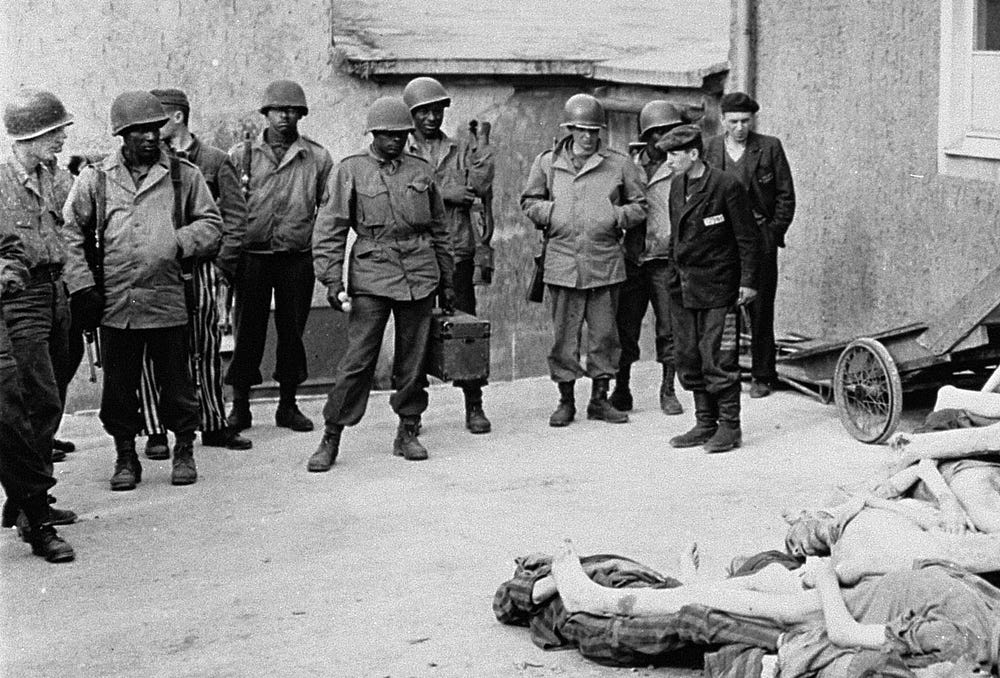How Nazi Germany weaponized the race card against the US Army
Propaganda efforts sought to exploit racial tensions
“There have never been lynchings of colored men in Germany. They have always been treated decently,” said the Nazi leaflet, dropped on African-American soldiers fighting across Europe. “So you don’t have to be afraid to be with Germans.”
“Uncle Sam’s colored soldiers are just cannon fodder!” another proclaimed.
Still another promised good food and fellowship if African-American troops would just surrender. “There’s no need to go on a diet. Plenty of food, nourishing, well-cooked and wholesome for all P.O.W.”

The Nazis were virulent racists who viewed history as a biologically driven struggle for survival and dominance between various peoples. They identified black people as an inferior, alien race that threatened the future existence of Western society. But that didn’t stop them from trying to exploit racial tensions among US forces to encourage desertion in the closing days of World War II. Creating wedges between people had been a Nazi strategy since the party’s inception.
The Nazis were skilled masters of what might be called today, niche marketing. Beginning in the 1920s, Adolf Hitler, Joseph Goebbels and the rest of the Nazi propaganda apparatus tailored messages to blue-collar workers, white-collar workers, men, women, Catholics, farmers — even blind Germans, despite the Nazi definition of “fitness.” The goal was to make the Nazi Party all things to all “Aryan” people while exploiting divisions wherever it was in the party’s interest.
The Nazis exploited people of African descent in their propaganda for political and military purposes. They were bogeymen, used as props to garner votes and later to incite Germans in “defense” of racial purity and their homeland.
From the start, the Nazi Party vilified black people as barbaric, uncivilized, and criminal. Hitler, in his autobiography, Mein Kampf, described blacks as tools in a plot by “international Jewry” to take over the world:
“It was and it is the Jews who bring the Negroes into the Rhineland, always with the same secret thought and clear aim of ruining the hated white race by the necessarily resulting bastardization, throwing it down from its cultural and political height, and himself rising to be its master.”

Nazi propagandists stressed to Germans that black people were participants in the nation’s humiliation following the Versailles Treaty, when African troops served in the French army’s postwar occupation of the Rhineland. In the Third Reich, black people, like Jews, were subjected to discriminatory legislation, including the notorious Nuremberg race laws of 1935, and were excluded on racial grounds from membership in the “national community.” In 1937, some 385 German children fathered by French-African troops were forcibly sterilized by German physicians in a secret Gestapo program.
Nazis decried the influence of “Negro Culture” on German art and music, seeing such works as “degenerate” and “racially alien.” In 1935, Eugen Hadomowsky, a high official with the Ministry of Public Enlightenment and Propaganda, prohibited German radio stations from broadcasting “N —-Jazz.” The Nazis identified jazz music, which had gained popularity in Germany in the 1920s during the Weimar Republic, with African-Americans and Jews.

But consistency wasn’t something the Nazi regime particularly cared about.
While the negative image of black people tended to predominate in the Nazi media, the regime’s propagandists also, on occasion, saw the benefit of using images of African-Americans as victims of racism to denounce foreign critics.
Following the international outcry against the pogroms perpetrated by the Nazis against the Reich’s Jews during Kristallnacht (the Night of Broken Glass) in November 1938, Goebbels’ propaganda ministry lashed out at American newspaper columnists and President Franklin Delano Roosevelt, denouncing them as hypocrites.
The SS newspaper, Das Schwarze Korps, for instance, made this point clearly in a front-page cartoon, “The Last Scream,” showing a Jewish Uncle Sam spouting the words, “We are protesting in the name of humanity against the barbaric methods in Germany.” Juxtaposed with this image were portrayals of screaming African-Americans being lynched and executed in the electric chair.
Of course, the Nazi view of all people of African descent was at least as dark as any promulgated in the United States. Posters such as the one below whipped up hatred of the enemy by reminding Germans “that French Negroes raped defenseless German women and shot down German workers like dogs in the name of this civilization.”

Still, what benefit did consistency have for Nazi Germany? Demonizing African-American soldiers as violent savages might help firm up the home front, but it could only make things harder on the battlefield.
In World War II, the belligerent nations dropped tons of leaflets on enemy lines to encourage opposing troops to surrender. In their leaflets for African-American soldiers, German propagandists tailored their message, repeatedly playing the race card, emphasizing overt racism in the United States. What kind of “free society” were African-Americans fighting for?
African-American soldiers would need no reminding of the inequalities of American life in the 1940s. The army itself was a segregated force and race riots erupted in Detroit and other American cities in 1943.

All the leaflets urged African-Americans soldiers to surrender to German troops rather than serving as cannon fodder for a white America that denied them equality.
The harder task would have been to convince anyone that life for African-Americans was better under Nazi rule. Propagandists implausibly whitewashed Nazi racism with claims that “colored people living in Germany can go to any church they like. They have never been a problem to the Germans,” as the leaflet below shows.

The Nazis also offered false comfort to those who surrendered. One leaflet showed a photograph of an African-American soldier in a German prisoner of war camp eating a heaping plate of food, while the other side contained a testimonial from a GI stating how well he was treated after his capture. In reality, provisions for Allied prisoners of war rapidly declined and the mortality rate increased as the war went on.
It is difficult to know what impact, if any, these fliers had on African-American soldiers, especially in late 1944, when Germany was nearing defeat. Long before these leaflets were dropped, America’s propaganda agency, the Office of War Information, reached out to blacks, pointing out what Nazi victory would mean for African-Americans.

The Allied liberation of the concentration camps ultimately exposed the horrific truth and consequences of Nazi racism. African-American soldiers were among those who saw first-hand evidence of Nazi crimes. Vincent Tubbs, a wartime correspondent for the Afro American, described the scenes he encountered in a Dachau subcamp:
“Inside I saw one of the Nazi atrocities you read about, see pictures of and are told about, but never believe until you’ve seen it for yourself. The charred bodies of uncountable men. . . . On my honor it was one of the most inhumane attempts at race extermination any people ever suffered. The inmates, those dead and those surviving out of the 4000 internees there, were Jews.”
Now, as in the past, these words and images serve as potent reminders of the evils of racism and antisemitism and as a moral imperative to confront hate propaganda.
Written by Steven Luckert, Ph.D., senior program curator at the US Holocaust Memorial Museum.
This article could not have been written without the generosity of Carter Boehm, who donated the treasure trove of Axis and Allied propaganda leaflets that his father, Edward, recovered on the battlefields of Italy while he was serving as an American officer in the Psychological Warfare Branch.








